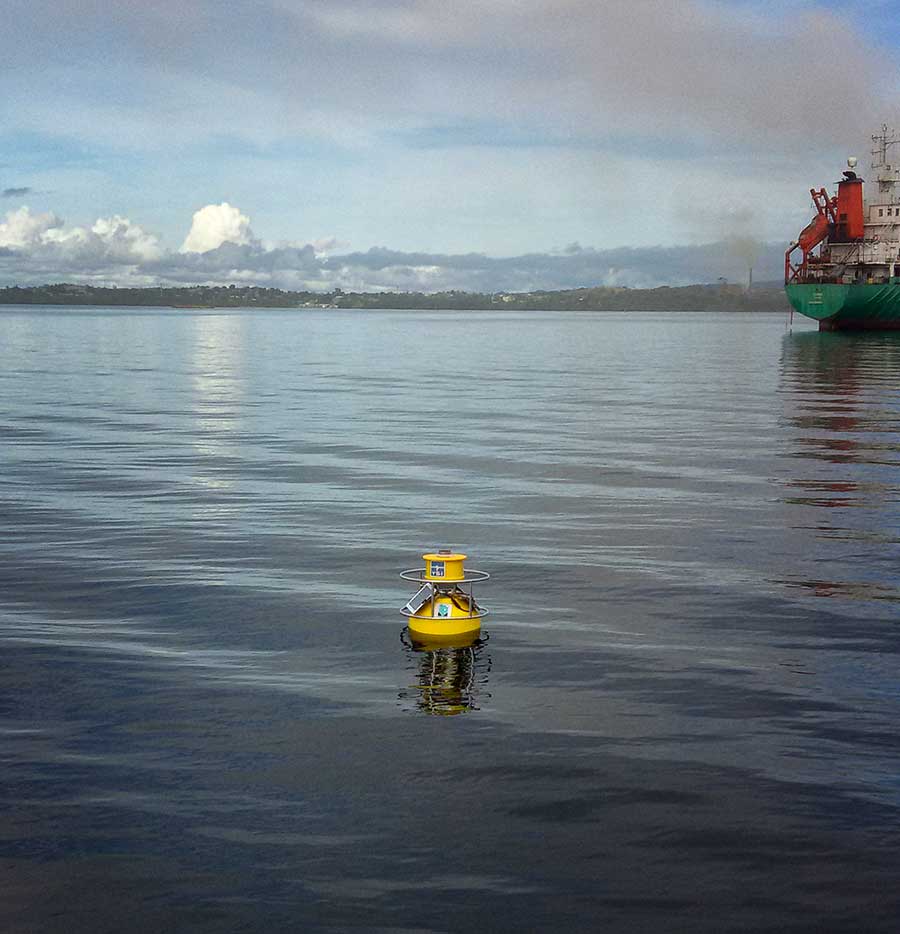
Above: The Water Quality Monitoring Buoy deployed in the Gulf of Paria. Photo courtesy Microsoft.
A new technology aimed at detecting the levels of pollution in the sea and its potential impact on aquatic life and the surrounding ecosystem was deployed in the waters of the Gulf of Paria on October 25. The Water Quality Monitoring Buoy, which was introduced during a ceremony held at the Claxton Bay Fishing Depot, will provide early detection of environmental incidents such as fish kills and oil spills.
This technology will provide a significant boost for underwater quality testing in Trinidad and Tobago (T&T) and it was made possible through a collective effort between Microsoft Caribbean and its partners on the project, the Institute of Marine Affairs (IMA), Fujitsu Caribbean and Digicel.
The prototype consists of underwater, wireless YSI sensors positioned on a buoy that utilise Fujitsu GlobeRanger software, Microsoft Azure and a cellular connection from Digicel to gather the critical data. The data will assist the IMA, which is the principal organisation responsible for marine and environmental research in T&T.
Speaking at the ceremony in Claxton Bay last Wednesday, the Honourable Camille Robinson-Regis, Minister of Planning and Development, signaled the importance of the partnership and the critical nature of the testing.
“Today we are deploying a solution, utilising the best practices in Private/Public partnerships. The Proof of Concept tool being implemented today is the type of initiative my Government has actively encouraged,” said Minister Robinson-Regis. “
Here the government agency, the IMA, has partnered with private sector interests and the end-users, the fisher folk, to develop an innovative instrument that is of national interest, and have national benefits.”
In addition to the Planning and Development Minister, Raquel Moses, Country Manager of Microsoft T&T, delivered remarks at the event.

Deploying the Water Quality Monitoring Buoy in the Gulf of Paria. Photo courtesy Microsoft. Click to enlarge.
“In September 2016, Microsoft approached the Institute of Marine Affairs of Trinidad and Tobago with a view to apply our technologies to enhance the IMA’s processes. These discussions have led us to this moment. The data processed from this buoy will now provide critical insight that can advance the IMA’s activities, which will in turn greatly benefit our country,” Moses said.
Jean-Paul Dookie, Head of Managed Infrastructure Services at Fujitsu Caribbean, stated that the collaboration illustrates the advancement this country can achieve through public-private partnerships.
“The IMA’s environmental water monitoring project is directly aligned with Fujitsu’s vision of a human centric intelligent society where we harness the power of Digital technology to innovate and co-create with our client the IMA, and our partner Microsoft to improve lives and contribute to a sustainable environment,” Dookie said.
The Water Quality Monitoring Buoy will remain in the Gulf for an initial six-month period with a goal to maintain its presence beyond that timeframe. The data collected from these sensors will be processed and analysed to provide critical insight into the levels of water pollution. Based on the success of this prototype, an effort will be made to have more buoys installed in the marine space across the country.
“The deployment of the buoy will be our eyes and ears in the Gulf of Paria, to gather critical data in real time that will help us to detect and respond to reports of oil spills, fish kills and other environmental incidents in a timely manner, thereby speeding up or improving the handling of environmental emergencies,” said Chairman Hayden Alexander on behalf of the IMA’s Board of Governors.
Kishore Boodram, Chairman of the Claxton Bay Fishing Association, delivered the welcome remarks. After the completion of the formal ceremony, guests were taken offshore to witness the deployment of the buoy in the waters of the Gulf of Paria.

